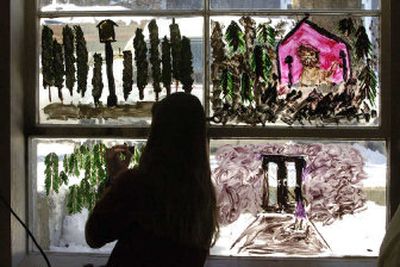The lion, witch and allegory

It’s on every desk in most of the classrooms at Southside Christian School.
For the past few weeks, “The Lion, the Witch and the Wardrobe” has been almost as popular as the Bible at this private, nondenominational Christian school in Spokane.
In anticipation of the Disney film that’s based on C.S. Lewis’ classic work, students in the fifth- through ninth-grades have been reading the book and talking about it during English class. They’re treating it not only as a piece of literature but also as Christian allegory: Like Jesus, Aslan, the lion, sacrifices his life to save a sinner then later rises from the dead to redeem the world.
“It’s another way to present who Christ is in a way that people can understand,” said Carli Robinson, who teaches English to eighth- and ninth-graders at Southside Christian. “It accentuates how Christ willingly shed his blood and died for us.”
Like other private Christian schools in the area and across the country, Southside Christian has fully incorporated the Disney movie into its lesson plans. Besides studying the novel and learning more about Lewis’ life and religious sensibilities, they’re also planning to see the movie together. Next Friday, students will dress up as queens, kings, centaurs, lions and other characters before heading to the theater.
Students and teachers at this small South Hill school hope “The Lion, the Witch and the Wardrobe” will have the same impact as the “Passion of the Christ,” which inspired religious audiences nationwide and set off a wave of evangelism. “Every day, we pray as a class that this will be a vehicle to glorify Christ,” said Robinson.
Since it was first published in 1950, “The Lion, the Witch and the Wardrobe” has sold more than 90 million copies. It’s the story of four children who are evacuated from London to the countryside during World War II. While staying at the home of an old professor, they discover a wardrobe – the gateway into the magical world of Narnia, a country ruled by a powerful witch but later freed by the Great Lion, Aslan.
Some readers remain oblivious to the religious themes, since Lewis never intended the books’ theology to be overt. The 15 students in Robinson’s class, however, were aware of the symbolism from the very beginning. Many had read “The Lion, the Witch and the Wardrobe” and the six other “Chronicles of Narnia” books when they were younger. Raised in Christian households, they were encouraged to search for parallels to Christian theology: the fall from grace, forgiveness, sacrifice, redemption.
“It’s mythical, but it speaks to real life,” said Lexi Haas, 13. “The way Aslan saved Edmund, Jesus saved me. I see myself in many of the characters.”
In the past three weeks, Robinson’s students have analyzed the plot, created a chronology, drawn intricate maps of Narnia. They’ve also taken it a step further: With the novel in one hand and the Bible in another, they focused on the character of the White Witch, the evil enchantress that cursed Narnia with an eternal winter.
Using passages from Scripture and descriptions from “The Lion, the Witch and the Wardrobe,” Robinson and her students compared the witch to Satan.
Together, they came up with a long list of traits that described both the character in the book and the devil, descriptions that included sly, cunning, deceptive, manipulative and powerful.
On Thursday morning during English class, several students recalled the Bible reading they had listened to earlier in the day. They compared how Satan tried to tempt Jesus after his 40-day fast in the wilderness, with the way the White Witch seduced Edmund, one of the four children who entered the wardrobe, with promises of power.
“They wait for opportune moments,” said 15-year-old Josh Watkins, as he and two other students examined the process of manipulation used by both the devil and the White Witch. “Moments when we’re weak, angry or tired.”
Unlike Aslan, the White Witch is rarely examined in class, said Robinson, explaining why they chose this particular character. “This is also helping us learn the different ways that Satan attacks us,” she told the class. “If you don’t know how Satan attacks you, you don’t know what kind of armor to use.”
It was a lesson that stuck with the students. As Haas led her fellow classmates in prayer, she asked God not only to bless them with creativity but to be aware of evil in the world.
“Help us see that Satan comes to us in ways we don’t understand,” said Haas. “Help us to be ready and to put on the shield of God.”